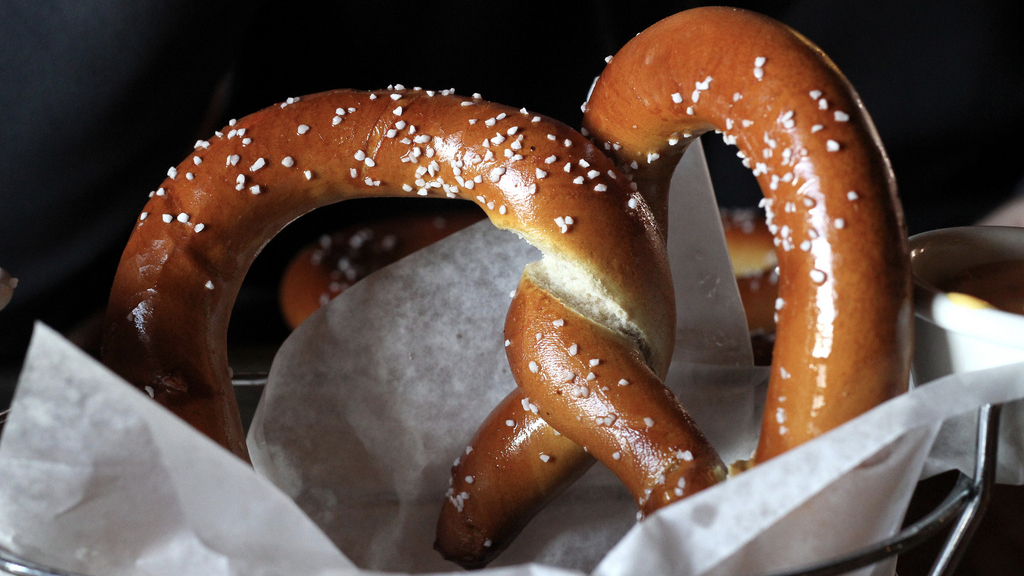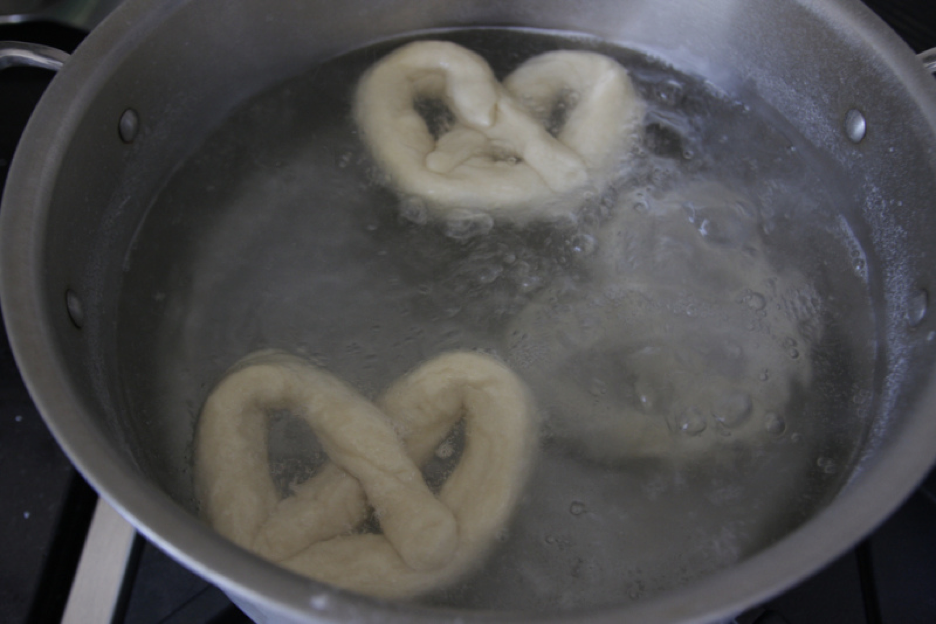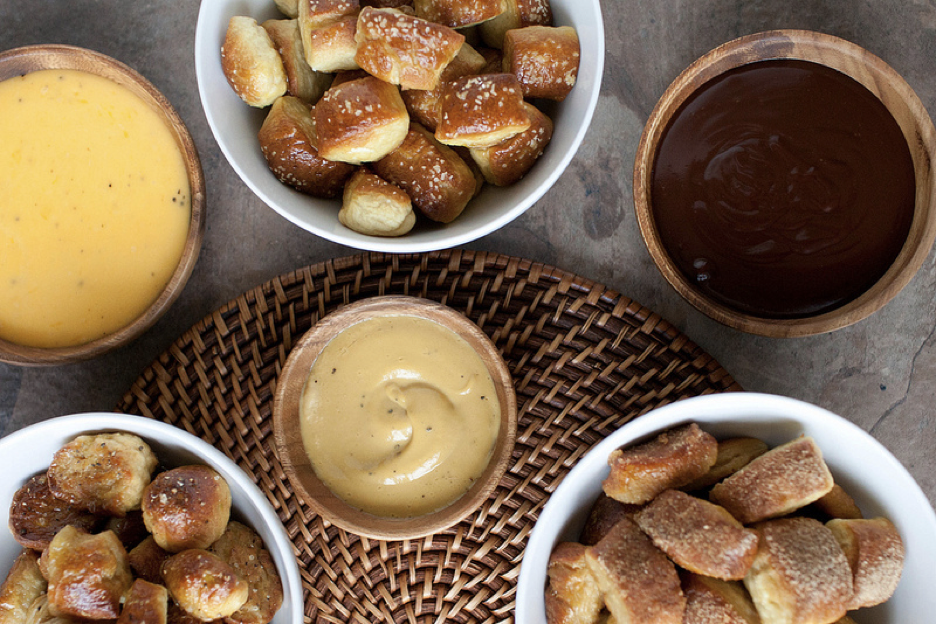Soft Pretzel HOW-TOs
Don’t you just love a chewy soft pretzel? Legend has it that the twisted pretzel originated in Italy during the 7th century, but today most people associate the treat with Germany.
Thank goodness we don’t have to go to Europe to find this wonderful treat. In fact, because they’re so easy to make, you don’t have to go anywhere to get one.

In my pretzel research, I found very clear and simple HOW-TO instructions on the great site, www.sheknows.com. Here’s what I learned:
“Soft pretzels are made with a simple yeasted dough that’s kneaded until it’s smooth and elastic. For the best flavor, the dough should rise in an oiled bowl, covered in plastic wrap, for 45 minutes.
“Once risen, you shape them. Just roll small dough balls into a thick strand about 8 inches long. Then, holding each end of the strand so you have a drooping letter U, lay the U onto a baking sheet lined with buttered parchment and cross the arms of the U in a hand-over-wrist motion. (If this is clear-as-mud, you can find oodles of Youtube videos on how to shape a pretzel.)

“To get a nice, golden brown color, they need to be boiled in an alkaline solution. Food-grade lye is traditional, but you can use baking soda, too (good thing, because who has food-grade lye hanging out in their kitchen?).
“If baking soda is what you’ll be using, it needs to be as close to the pH of lye as possible. So, to get the pH closer to that of lye, bake the soda in your oven at 300 degrees F for about an hour, then add it to a big pot of boiling water.
“Also, traditionally, barley malt syrup is added to the water, but you can use brown sugar in a pinch.
“With your ingredients added to the water, it’s time to boil your pretzels. Gently lower 2 to 3 pretzels into the water. Boil for 30 seconds, then flip, and cook for another 30 seconds. Remove from the water with a slotted spoon or spider strainer. They’ll look kind of wrinkled, but they’ll smooth out in the baking. Place the pretzels on a baking sheet covered with buttered parchment paper or a silicone liner.

“For savory pretzels, brush the dough with an egg wash, and sprinkle with salt — coarse kosher salt or sea salt works well here, but you can even get special pretzel salt too. For sweet pretzels, brush the tops with melted butter, cinnamon and sugar. For vegan pretzels, you can just use water instead of egg wash or butter.
“Finally, bake them for 15 minutes at 450 degrees F until golden brown.”

Now, a fun idea before I share a terrific recipe (adapted from Martha Stewart) for homemade pretzels: What’s better than one big, soft pretzel? Dozens of small ones. Pretzel bites, we call ‘em. And like the big guys, they can be savory or sweet; you choose.

2 cups warm water (100°F to 110°F)
3 tablespoons sugar
1 packet active dry yeast
5 to 6 cups all-purpose flour plus more for dusting
1 tablespoon salt
2 teaspoons canola oil or other neutral oil
1/4 cup baking soda
1 large egg
coarse or pretzel salt
vegetable oil cooking spray
Directions:
Add Recipe to Cook'n
Thank goodness we don’t have to go to Europe to find this wonderful treat. In fact, because they’re so easy to make, you don’t have to go anywhere to get one.

In my pretzel research, I found very clear and simple HOW-TO instructions on the great site, www.sheknows.com. Here’s what I learned:
“Soft pretzels are made with a simple yeasted dough that’s kneaded until it’s smooth and elastic. For the best flavor, the dough should rise in an oiled bowl, covered in plastic wrap, for 45 minutes.
“Once risen, you shape them. Just roll small dough balls into a thick strand about 8 inches long. Then, holding each end of the strand so you have a drooping letter U, lay the U onto a baking sheet lined with buttered parchment and cross the arms of the U in a hand-over-wrist motion. (If this is clear-as-mud, you can find oodles of Youtube videos on how to shape a pretzel.)

“To get a nice, golden brown color, they need to be boiled in an alkaline solution. Food-grade lye is traditional, but you can use baking soda, too (good thing, because who has food-grade lye hanging out in their kitchen?).
“If baking soda is what you’ll be using, it needs to be as close to the pH of lye as possible. So, to get the pH closer to that of lye, bake the soda in your oven at 300 degrees F for about an hour, then add it to a big pot of boiling water.
“Also, traditionally, barley malt syrup is added to the water, but you can use brown sugar in a pinch.
“With your ingredients added to the water, it’s time to boil your pretzels. Gently lower 2 to 3 pretzels into the water. Boil for 30 seconds, then flip, and cook for another 30 seconds. Remove from the water with a slotted spoon or spider strainer. They’ll look kind of wrinkled, but they’ll smooth out in the baking. Place the pretzels on a baking sheet covered with buttered parchment paper or a silicone liner.

“For savory pretzels, brush the dough with an egg wash, and sprinkle with salt — coarse kosher salt or sea salt works well here, but you can even get special pretzel salt too. For sweet pretzels, brush the tops with melted butter, cinnamon and sugar. For vegan pretzels, you can just use water instead of egg wash or butter.
“Finally, bake them for 15 minutes at 450 degrees F until golden brown.”

Now, a fun idea before I share a terrific recipe (adapted from Martha Stewart) for homemade pretzels: What’s better than one big, soft pretzel? Dozens of small ones. Pretzel bites, we call ‘em. And like the big guys, they can be savory or sweet; you choose.

Soft Pretzels
Yield: 16 full-sized or 32 miniatures
Ingredients:
2 cups warm water (100°F to 110°F)
3 tablespoons sugar
1 packet active dry yeast
5 to 6 cups all-purpose flour plus more for dusting
1 tablespoon salt
2 teaspoons canola oil or other neutral oil
1/4 cup baking soda
1 large egg
coarse or pretzel salt
vegetable oil cooking spray
Directions:
1. Pour warm water and 1 tablespoon sugar into bowl of electric mixer fitted with a dough hook* and stir to combine. Sprinkle with yeast, and let sit 10 minutes; yeast should be foamy.
2. Add 1 cup flour to yeast, and mix on low until combined. Add salt and 4 cups more flour, and mix until combined, about 30 seconds. Beat on medium-low until dough pulls away from sides of bowl, about 1 1/2 minutes. Add another 1/2 cup flour, and knead on low 1 minute more. If dough is still wet and sticky, add 1/2 cup more flour (this will depend on weather conditions); knead until combined, about 30 seconds. Transfer to a lightly floured board, and knead about ten times, or until smooth.
3. Pour oil into a large bowl; swirl to coat sides. Transfer dough to bowl, turning dough to completely cover all sides. Cover with a kitchen towel, and leave in a warm spot for 1 hour, or until dough has doubled in size.
4. Heat oven to 450°F. Lightly spray two baking sheets with cooking spray (parchment paper, ungreased, also works). Set aside. Punch down dough to remove bubbles. Transfer to a lightly floured board. Knead once or twice, divide into 16 pieces (about 2 1/2 ounces each) or 32 if making miniature pretzels, and wrap in plastic.
5. Roll one piece of dough at a time into an 18-inch-long strip. [I find the pretzels much easier to roll on an unfloured board, oddly enough, but see what works for you.] Twist into pretzel shape; transfer to prepared baking sheet. Cover with a kitchen towel. Continue to form pretzels; eight will fit on each sheet (you may need a third sheet if making miniatures). Let pretzels rest until they rise slightly, about 15 minutes.
6. Meanwhile, fill large, shallow pot with 2 inches of water. Bring to a boil. Add baking soda (and step back, it foams up quickly) and remaining 2 tablespoons sugar. Reduce to a simmer; transfer three to four pretzels to water. Poach 1 minute on each side. Use slotted spoon to transfer pretzels to baking sheet. Continue until all pretzels are poached.
7. Beat egg with 1 tablespoon water. Brush pretzels with egg glaze. Sprinkle with salt. Bake until golden brown, 12 to 15 minutes. Let cool on wire rack, or eat warm. Pretzels are best when eaten the same day, but will keep at room temperature, uncovered, for two days. Do not store in covered container or they will become soggy.
2. Add 1 cup flour to yeast, and mix on low until combined. Add salt and 4 cups more flour, and mix until combined, about 30 seconds. Beat on medium-low until dough pulls away from sides of bowl, about 1 1/2 minutes. Add another 1/2 cup flour, and knead on low 1 minute more. If dough is still wet and sticky, add 1/2 cup more flour (this will depend on weather conditions); knead until combined, about 30 seconds. Transfer to a lightly floured board, and knead about ten times, or until smooth.
3. Pour oil into a large bowl; swirl to coat sides. Transfer dough to bowl, turning dough to completely cover all sides. Cover with a kitchen towel, and leave in a warm spot for 1 hour, or until dough has doubled in size.
4. Heat oven to 450°F. Lightly spray two baking sheets with cooking spray (parchment paper, ungreased, also works). Set aside. Punch down dough to remove bubbles. Transfer to a lightly floured board. Knead once or twice, divide into 16 pieces (about 2 1/2 ounces each) or 32 if making miniature pretzels, and wrap in plastic.
5. Roll one piece of dough at a time into an 18-inch-long strip. [I find the pretzels much easier to roll on an unfloured board, oddly enough, but see what works for you.] Twist into pretzel shape; transfer to prepared baking sheet. Cover with a kitchen towel. Continue to form pretzels; eight will fit on each sheet (you may need a third sheet if making miniatures). Let pretzels rest until they rise slightly, about 15 minutes.
6. Meanwhile, fill large, shallow pot with 2 inches of water. Bring to a boil. Add baking soda (and step back, it foams up quickly) and remaining 2 tablespoons sugar. Reduce to a simmer; transfer three to four pretzels to water. Poach 1 minute on each side. Use slotted spoon to transfer pretzels to baking sheet. Continue until all pretzels are poached.
7. Beat egg with 1 tablespoon water. Brush pretzels with egg glaze. Sprinkle with salt. Bake until golden brown, 12 to 15 minutes. Let cool on wire rack, or eat warm. Pretzels are best when eaten the same day, but will keep at room temperature, uncovered, for two days. Do not store in covered container or they will become soggy.
Recipe formatted with the Cook'n Recipe Software from DVO Enterprises.
Sources:
- www.sheknows.com
- www.thekitchen.com
 Alice Osborne
Alice Osborne
Weekly Newsletter Contributor since 2006
Email the author! alice@dvo.com
